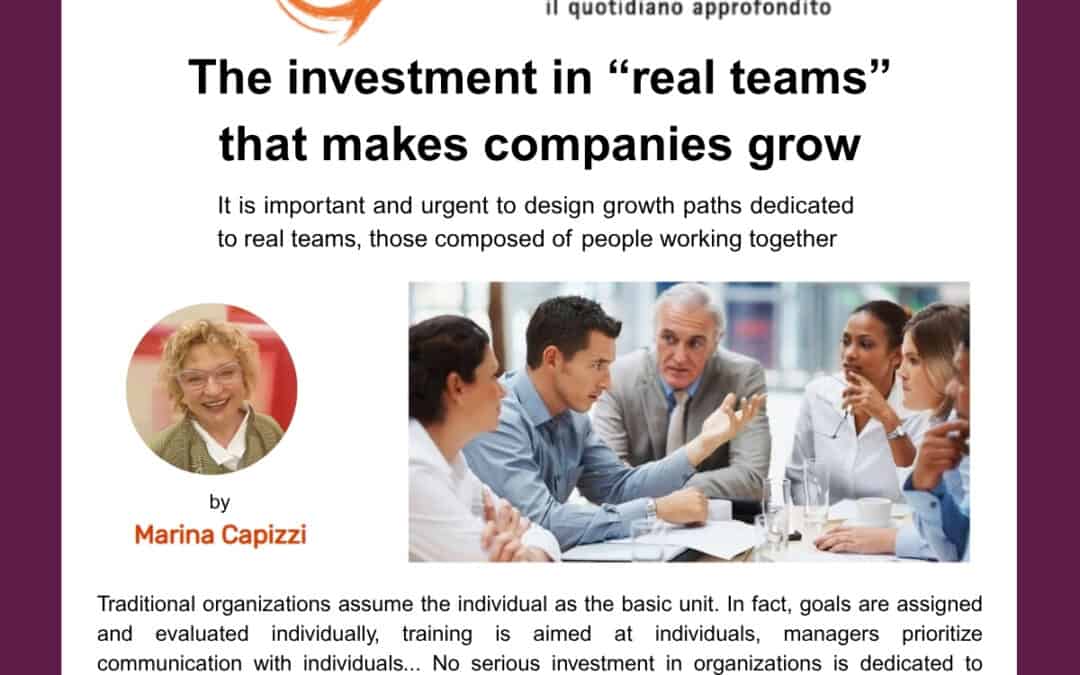This is the English translation of the article published on “Il Sussidiario” (June 1st, 2025)
It is important and urgent to design growth paths dedicated to real teams, those composed of people working together
Traditional organizations assume the individual as the basic unit. In fact, goals are assigned and evaluated individually, training is aimed at individuals, managers prioritize communication with individuals… No serious investment in organizations is dedicated to supporting real teams, those composed of people working together (apart from very brief team building that hardly leaves a lasting impression).
Individual performance, of course, is very important. But in the complex and interconnected world in which we live, can we still think that results are not strongly influenced by how people work together and the presence or absence of psychological safety?
When the world was simpler and more stable, most people worked by performing individual, repetitive and normed “tasks” whose control was delegated to “superiors.” These tasks were the result of a great fragmentation of activities which, reassembled through the assembly line and other processes supervised by the hierarchy, produced a car, a suit, the opening and management of a bank account, and so on.
This world no longer exists. Continuous and sudden changes, technological developments and the emergence of increasingly sophisticated, varied and changing needs have made products and services very complex in their conception, production and diversification. Each step requires the interaction, comparison and contribution of different skills and the need for people to work together.
There is no such thing as individual performance anymore. The place where performance arises is the team, the basic unit of modern organizations. This changes everything for everyone. It changes the way people think and conceive of themselves in a team. It changes the meaning of the hierarchical role, which no longer expresses itself in command/control, but in fostering the work of teams and among teams so that everyone can make their voices heard, communicate transparently, confront each other candidly, and continue to learn and innovate to contribute to the common goal. The basic condition that enables teams to work in this way is “psychological safety.”
As I wrote in a previous article, only if you cultivate psychological safety, you will create a climate that encourages people to express themselves and contribute to continuous improvement, every day, in offices, production units, project teams, stores… And this way of working promotes people’s well-being and organizations’ results. Because the organization becomes faster if those who perceive an opportunity or notice that something is wrong tell others promptly.
If people express their ideas. If, when there is a problem to be solved, all the skills that are needed are around the table. If people talk to each other frankly and share their mistakes in a timely manner to repair, learn and prevent them.
But teams only function in this way if people, when they work, have the belief that they will not be punished, humiliated or isolated if they make their voices heard. Thus, to evolve their culture and keep up with the world, it is crucial that organizations direct their training and development investments on teams and among teams.
Let’s remember that we were forged to take care of just our little piece… That’s why it is important and urgent to design growth paths dedicated to real teams, because this is where the results of the enterprise and its competitiveness are at stake, as well as people’s chance to get satisfaction from their work. And psychological safety is the first step, also for other investments to take root.
Organizations have a responsibility to develop projects in this direction. But how can managers and leaders cultivate psychological safety in their teams by creating stimulating and safe environments? We will discuss this in a future article.
By Marina Capizzi, author of Hierarchy to Die or to Thrive?
